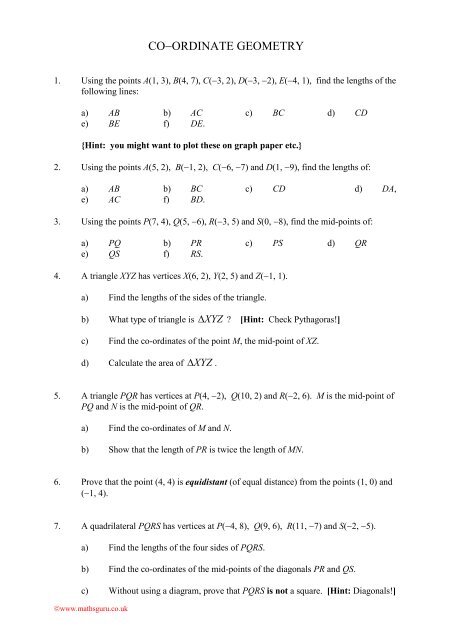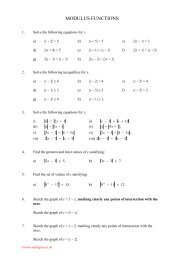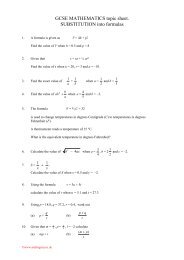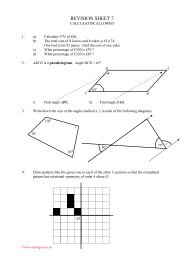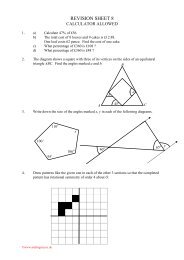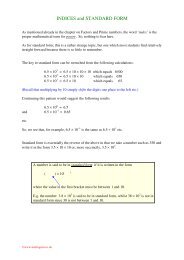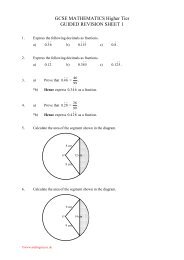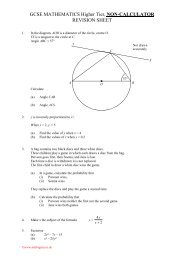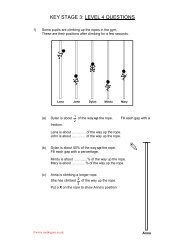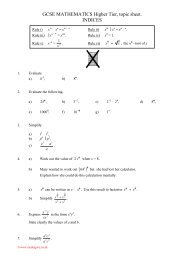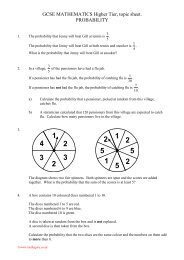CO-ORDINATE GEOMETRY
CO-ORDINATE GEOMETRY
CO-ORDINATE GEOMETRY
Create successful ePaper yourself
Turn your PDF publications into a flip-book with our unique Google optimized e-Paper software.
<strong>CO</strong><strong>ORDINATE</strong> <strong>GEOMETRY</strong><br />
1. Using the points A(1, 3), B(4, 7), C(3, 2), D(3, 2), E(4, 1), find the lengths of the<br />
following lines:<br />
a) AB b) AC c) BC d) CD<br />
e) BE f) DE.<br />
{Hint: you might want to plot these on graph paper etc.}<br />
2. Using the points A(5, 2), B(1, 2), C(6, 7) and D(1, 9), find the lengths of:<br />
a) AB b) BC c) CD d) DA,<br />
e) AC f) BD.<br />
3. Using the points P(7, 4), Q(5, 6), R(3, 5) and S(0, 8), find the mid-points of:<br />
a) PQ b) PR c) PS d) QR<br />
e) QS f) RS.<br />
4. A triangle XYZ has vertices X(6, 2), Y(2, 5) and Z(1, 1).<br />
a) Find the lengths of the sides of the triangle.<br />
b) What type of triangle is XYZ ? [Hint: Check Pythagoras!]<br />
c) Find the co-ordinates of the point M, the mid-point of XZ.<br />
d) Calculate the area of XYZ .<br />
5. A triangle PQR has vertices at P(4, 2), Q(10, 2) and R(2, 6). M is the mid-point of<br />
PQ and N is the mid-point of QR.<br />
a) Find the co-ordinates of M and N.<br />
b) Show that the length of PR is twice the length of MN.<br />
6. Prove that the point (4, 4) is equidistant (of equal distance) from the points (1, 0) and<br />
(1, 4).<br />
7. A quadrilateral PQRS has vertices at P(4, 8), Q(9, 6), R(11, 7) and S(2, 5).<br />
a) Find the lengths of the four sides of PQRS.<br />
b) Find the co-ordinates of the mid-points of the diagonals PR and QS.<br />
c) Without using a diagram, prove that PQRS is not a square. [Hint: Diagonals!]<br />
www.mathsguru.co.uk
8. The distance between the points (a, 0) and (0, a) is equal to the distance between the<br />
points (1, 2) and (1, 3). Find the possible values of a.<br />
{Hint: using the distance formula, the distance between (a, 0) and (0, a) is<br />
2<br />
2<br />
( 0 ) + ( aawhich 0) equals<br />
2<br />
2a<br />
etc.}<br />
9. By rearranging the following straight line formulas into the form y = mx + c (if<br />
needed) find the gradients and intercepts of the lines.<br />
a) y = 3x + 1. b) y = 4x 1. c) y = 3 + 2x.<br />
d) y = 2 3x. e) y + 3x = 1. f) y 4x = 3.<br />
g) 2x + y = 7. h) 2y = 2 + 6x. i) 3y + 9x = 12.<br />
j) 2y 8 = 2x. k) y x + 2 = 0. l) y + 4x 1 = 0.<br />
m) 2y = 6 + 3x. n) 2y = 2 5x. o) 3y + 2x = 9.<br />
p) 3y 3x = 6. q) 7 = 2x y. r) 6x = 2 2y.<br />
s) y = x + 2. t) y = 2 3x. u) 2y = 4 x.<br />
v) 2x + y = 0. w) 6x 3y = 9. x) 7x + 3y = 9.<br />
y) x + 2y + 7 = 0. z) y = 7.<br />
10. 8 points have co-ordinates as follows.<br />
A(3, 4) B(6, 10) C(8, 3) D(6, 2) E(0, 5)<br />
F(4, 7) G(1, 4) H(4, 2).<br />
11<br />
y<br />
10<br />
B<br />
9<br />
8<br />
7<br />
6<br />
5<br />
H<br />
4<br />
3<br />
2<br />
A<br />
C<br />
1<br />
0<br />
-5 -4 -3 -2 -1 0<br />
-1<br />
1 2 3 4 5 6 7 8<br />
x<br />
9<br />
-2<br />
D<br />
G<br />
-3<br />
-4<br />
-5<br />
E<br />
F<br />
-6<br />
-7<br />
-8<br />
www.mathsguru.co.uk
i) Find, by calculation, the gradients of the following lines:<br />
a) AB b) DC c) BC d) AG<br />
e) AE f) GE g) FG h) ED<br />
i) HA j) FE.<br />
ii)<br />
iii)<br />
iv)<br />
Show, by calculation, that HG is parallel to AD.<br />
Show, by calculation, that the points A, B and G are collinear<br />
(lie on a straight line).<br />
Show, by calculation, that the points D, E and F are collinear.<br />
11. A quadrilateral has vertices P(0, 4), Q(2, 1), R(0, 2) and S(4, 2).<br />
Show, by finding one pair of parallel sides, that PQRS is a trapezium.<br />
{Draw a diagram first.}<br />
12. Work out the gradients of PQ and QR where P = (3, 1), Q = (1, 4) and R = (9, 10).<br />
What can be said about the points P, Q and R ?<br />
13.<br />
y<br />
12<br />
11<br />
K<br />
10<br />
9<br />
8<br />
E<br />
L<br />
F<br />
7<br />
6<br />
H<br />
J<br />
C<br />
D<br />
B<br />
5<br />
4<br />
3<br />
I<br />
2<br />
G<br />
1<br />
A<br />
N<br />
0<br />
x<br />
-6 -5 -4 -3 -2 -1<br />
-1<br />
0 1 2 3 4 5 6 7 8 9 10 11 12<br />
-2<br />
R<br />
O<br />
-3<br />
Q<br />
-4<br />
www.mathsguru.co.uk<br />
-5<br />
-6<br />
M<br />
P
Each of the following pairs of line segments are perpendicular (at right-angles to<br />
each other). Work out the gradients of each pair of lines.<br />
i) AB and AC. ii) DE and DF. iii) GH and GI.<br />
iv) JK and JL. v) MN and MO. vi) PQ and PR.<br />
14. a) Which of the following lines are parallel to the line with equation y = 2x + 1 ?<br />
i) y = 2x 3 ii) y = 1 2x iii) y = 1 x + 1 2<br />
iv) y = 5 + 2x.<br />
b) Which of the following lines are perpendicular to the line with equation<br />
y = 2x + 1?<br />
i) y = 2x 3 ii) y = 1 2x iii) y = 1 x + 1 2<br />
iv) y = 5 + 2x.<br />
c) Which of the following lines are parallel to the line with equation y = 3x + 2 ?<br />
i) y = 4x + 2 ii) y = 2 1 x 3 iii) y = 1 x + 1 3<br />
iv) y = 3x 1.<br />
d) Which of the following lines are perpendicular to the line with equation<br />
y = 3x + 2 ?<br />
i) y = 4x + 2 ii) y = 2 1 x 3 iii) y = 1 x + 1 3<br />
iv) y = 3x 1.<br />
e) Which of the following lines are parallel to the line with equation y = 2 4x ?<br />
i) y = 4x + 1 ii) y = 3 4x iii) y = 1 x + 1 4<br />
iv) y = 1 x 1. 4<br />
f) Which of the following lines are perpendicular to the line with equation<br />
y = 2 4x ?<br />
i) y = 4x + 1 ii) y = 3 4x iii) y = 1 x + 1 4<br />
iv) y = 1 x 1. 4<br />
15. For each of the following, calculate the gradients of AB and CD and hence determine<br />
whether the line AB is parallel or perpendicular to the line CD.<br />
a) A(0, 1), B(1, 1), C(1, 5), D(1, 1)<br />
b) A(1, 1), B(3, 2), C(1, 1), D(0, 1)<br />
c) A(3, 3), B(3, 1), C(1, 1), D(1, 7)<br />
d) A(2, 6), B(1, 9), C(2, 11), D(0, 1).<br />
16. The points A(1, 5), B(4, 1) and C(2, 4) form a triangle ABC.<br />
a) Calculate the gradients of AB, BC and AC.<br />
b) Show that the angle ABC = 90 o .<br />
{Hint: check the product of the gradients of AB and BC etc.}<br />
c) Find the area of the triangle ABC.<br />
www.mathsguru.co.uk
17. Show that the triangle formed by the points (2, 5), (1, 3) and (5, 9) is right-angled.<br />
18. A quadrilateral ABCD is formed by the points A(3, 2), B(4, 3), C(9, 2) and<br />
D(2, 3).<br />
a) Show that all four sides are equal in length.<br />
{Hint: use the distance formula.}<br />
b) Show that ABCD is not a square.<br />
{Hint: show that one pair of adjacent sides are not perpendicular by<br />
checking the product of the gradients etc.}<br />
19. A circle, radius 2 units, centre the origin, cuts the xaxis at the points A and B and cuts<br />
the positive yaxis at C.<br />
a) Write down the coordinates of the points A, B and C.<br />
b) Use gradients to prove that the angle ACB = 90 o .<br />
{This is true for any angle in a semi-circle.}<br />
20. ABCD is a quadrilateral where A, B, C and D are the points (3, 1), (6, 0), (7, 3) and<br />
(4, 2) respectively.<br />
Prove that the diagonals bisect each other at rightangles.<br />
www.mathsguru.co.uk<br />
{Hint: find the mid-points of the diagonals AC and BD to check bisection.<br />
Use gradients to show that the diagonals are at rightangles to each<br />
other.}<br />
21. Find the equations of the following lines.<br />
a) Passing through A(1, 1) with gradient 1,<br />
b) Passing through A(3, 2) with gradient 1 3 ,<br />
c) Passing through A(0, 4) with gradient 3,<br />
d) Passing through (8, 1) with gradient = 3,<br />
e) Passing through (4, 5) with gradient = 2 3 ,<br />
f) Passing through (7, 0) with gradient = 1 1 2 .<br />
22. Find the equations of the lines which pass through the following pairs of points.<br />
a) (2, 2) and (8, 5) b) (7, 5) and (3, 7)<br />
c) (3, 2) and (3, 4) d) (2, 3) and (3, 2)<br />
e) (4, 2) and (3, 8) f) (4, 3) and (6, 0).<br />
23. a) Find, in the form y = mx + c, the equation of the line with gradient 2 3 and<br />
passing through the point (2, 2)<br />
b) Rearrange the formula to show that the equation of the line can be written<br />
3y 2x = 2.<br />
c) Use algebra to verify that the line passes through the point (8, 6).
24. a) Find the equation of the line which passes through the points (2, 2) and (5, 8).<br />
b) Does the line pass through the point ( 2, 6 ) ?<br />
Give a reason for your answer.<br />
25. a) Find the gradient of the line joining the points A ( 1,<br />
2) and B(3, 4).<br />
b) Hence find the equation of the line joining the points A and B in the form<br />
y = mx + c.<br />
c) Rearrange the formula to show that the equation of the line can be written<br />
2y x = 5.<br />
d) The line cuts the x-axis at the point P and the y-axis at the point Q.<br />
Find the co-ordinates of P and Q.<br />
y<br />
2y x = 5<br />
Q<br />
P<br />
x<br />
26. a) Find the gradient of the line joining the points A ( 1,<br />
3) and B(4, 1).<br />
b) Hence find the equation of the line joining the points A and B in the form<br />
y = mx + c.<br />
c) Rearrange the formula to show that the equation of the line can be written<br />
3y + 2x = 11.<br />
d) The line cuts the x-axis at the point P and the y-axis at the point Q.<br />
y<br />
Find the co-ordinates of P and Q.<br />
3y + 2x =11<br />
Q<br />
27. Points A and B have co-ordinates (3, 1) and (7, 4).<br />
P<br />
x<br />
a) Find the co-ordinates of M, the midpoint of AB.<br />
b) Find the gradient of AB.<br />
c) Find the equation of the perpendicular bisector of AB.<br />
d) Find the co-ordinates of the point where this line crosses the x-axis.<br />
www.mathsguru.co.uk<br />
A<br />
M<br />
B
28. The coordinates of A and B are (3, 2) and (4, 5) respectively. Find the coordinates<br />
of the midpoint of AB and the gradient of AB.<br />
Hence find the equation of the perpendicular bisector of AB, giving your answer in the<br />
form ax + by + c = 0, where a, b and c are integers.<br />
29. The coordinates of A and B are (3, 3) and (6, 0) respectively. Find the coordinates<br />
of the midpoint of AB and the gradient of AB.<br />
Hence find the equation of the perpendicular bisector of AB, giving your answer in the<br />
form ax + by + c = 0, where a, b and c are integers.<br />
30. The equation of the straight line l 1 is x + 3y 33 = 0. The point P is (3, 0) and the<br />
point Q is (6, 9).<br />
The straight line l 2 is parallel to l 1 and passes through P.<br />
i) Find the equation of l 2 , giving your answer in the form ax + by + c = 0.<br />
ii) Verify that Q lies on l 1 .<br />
iii) Show that the line joining P and Q is perpendicular to l 1 .<br />
iv) Find the perpendicular distance between l 1 and l 2 .<br />
31. The equation of the straight line l 1 is x + 6y 24 = 0. The point P is (1, 64) and the<br />
point Q is (12, 2). The straight line l 2 is parallel to l 1 and passes through P.<br />
i) Find the equation of l 2 , giving your answer in the form ax + by + c = 0.<br />
ii) Verify that Q lies on l 1 .<br />
iii) Show that the line joining P and Q is perpendicular to l 1 .<br />
iv) Find the perpendicular distance between l 1 and l 2 .<br />
32. The straight line p passes through the point (10, 1) and is perpendicular to the line r<br />
with equation 2x + y = 1. Find the equation of p.<br />
Find also the coordinates of the point of intersection of p and r, and deduce the<br />
perpendicular distance from the point (10, 1) to the line r.<br />
33. The quadrilateral ABCD has vertices A(2, 5), B(0, 9), C(5, 6) and D(3, 6).<br />
a) Find the equations of the diagonals AC and BD.<br />
b) Find the coordinates of the point, P, where these two diagonals meet.<br />
{Hint: simultaneous equations!}<br />
c) Show that P is not the midpoint of either of the two diagonals.<br />
34. a) Find the equation of the perpendicular from the point A(5, 3) to the line<br />
2x y + 4 = 0.<br />
b) Find the co-ordinates of the point P where the two lines meet.<br />
2x y + 4 = 0<br />
c) Hence find the shortest distance from A to the line<br />
2x y + 4 = 0.<br />
P<br />
www.mathsguru.co.uk<br />
A
35.<br />
y<br />
B<br />
C<br />
A<br />
O<br />
x<br />
The diagram, not drawn to scale, shows a trapezium OABC with OA parallel to CB.<br />
Given that B is the point (4, 3), C is the point (0, 2) and the diagonal CA is parallel to<br />
the xaxis, calculate the coordinates of A.<br />
{Hint: you do not need to find the equations of any lines etc.!}<br />
36. The diagram shows a square OABC. A is the point (7, 1).<br />
y<br />
B<br />
Find, in any order, the coordinates of B and C.<br />
C<br />
A(7, 1)<br />
O<br />
x<br />
www.mathsguru.co.uk
Answers.<br />
1. a) 5 units b) 17 units c) 74 units d) 4 units<br />
e) 10 units f) 10 units.<br />
2. a) 6 units b) 106 units c) 53 units<br />
d) 137 units e) 202 units f) 125 units<br />
3. a) (6, 1) b) (2, 45) c) (35, 2)<br />
d) (1, 05) e) (25, 7) f) (15, 15).<br />
4. a) XY = 5 units, YZ = 5 units, XZ = 50 units.<br />
b) Isosceles & rightangled.<br />
c) M = (25, 15).<br />
d) 125 units 2 .<br />
5. a) M = (7, 0), N = (4, 4). b) PR = 10 units, MN = 5 units etc.<br />
7. a) All 4 sides are of length 173 units.<br />
b) both mid-points coincide at (35, 05).<br />
c) {PQRS is actually a rhombus!}.<br />
8. a = ± 5 2 .<br />
9. a) 3, 1. b) 4, 1. c) 2, 3. d) 3, 2.<br />
e) 3, 1. f) 4, 3. g) 2, 7. h) 3, 1.<br />
i) 3, 4. j) 1,4. k) 1, 2. l) 4, 1.<br />
m) 1.5, 3. n) 2.5, 1. o) 3<br />
2 , 3. p) 1, 2.<br />
q) 2, 7. r) 3, 1. s) 1, 2. t) 3, 2.<br />
u) 1 2 , 2. v) 2, 0. w) 2, 3. x) 7 3 , 3.<br />
y) 1 2 , 35. z) 0, 7.<br />
10. i) a) 2 b) 25 c) 35<br />
d) 2 e) 3 f) 1<br />
www.mathsguru.co.uk<br />
g) 1 h)<br />
j)<br />
1<br />
2 .<br />
1<br />
2 i)<br />
11. QR and PS both have gradients of 1.5 and thus are parallel.<br />
12. Both gradients = 43<br />
. P, Q and R are collinear (lie on a straight line).<br />
13. i) AB = 1, AC = 1.<br />
ii) DE = 2, DF = 1 . 2<br />
iii) GH = 4, GI = 1 . 4<br />
iv) JK = 5, JL = 1 . 5<br />
v) MN = 3, MO = 1 . 3<br />
vi) PQ = 1 2<br />
, PR = 2.<br />
The product of the gradinets of perpendicular lines = 1 !!!<br />
14. a) i) and iv).<br />
b) iii).<br />
c) iv).<br />
d) ii).<br />
e) i) and ii).<br />
f) iii).<br />
15. a) 2, 2; parallel b)<br />
2<br />
7<br />
1<br />
2 , 2; perpendicular<br />
1<br />
c) 3 , 3; perpendicular d) 5,5; parallel.<br />
16. a) 2, 1 2 , 3 respectively.
) Check that the product of the appropriate gradients = 1.<br />
c) 225 units 2 .<br />
19. a) A(2, 0), B(2, 0) or visaversa. C(0, 2).<br />
21. a) y = x b) 3y = x 9 c) y = 4 3x<br />
d) y = 3x 23 e) 3y = 2x 23 f) 3x + 2y = 21<br />
22. a) 2y = x + 2. b) y = 3x 16 c) 3y + x = 9<br />
d) y = x + 1 e) y = 6x 26 f) 2y 3x + 18 = 0.<br />
23. a) y = 2 2<br />
3 x + 3 c) 3y 2x = 3×6 2×8 = 2 and thus (8, 6) lies on<br />
the line.<br />
24. a) y = 2x 2 b) No. Why?<br />
1<br />
25. a) 2 b) y = 1 5<br />
2 x + 2<br />
d) P = (5, 0), Q = ( 0, 5 2)<br />
.<br />
26. a) 2 3 . b) y = 2 11<br />
3 3<br />
0, 11 3 .<br />
3<br />
27. a) (2, 25). b) 10 . c) 6y = 55 20x d) (275, 0).<br />
28. (35, 15). 7. 7y x + 2 = 0.<br />
1<br />
29. (15, 15). 3 . y + 3x + 3 = 0.<br />
30. i) x + 3y 3 = 0. ii) check coordinates of Q satisfy equation of l 1 .<br />
iii) check product of gradients etc. iv) 90 units.<br />
31. i) x + 6y + 383 = 0. ii) check coordinates of Q satisfy equation of l 1 .<br />
iii) check product of gradients etc. iv) 4477 units.<br />
32. 2y = x 8. (2, 3). 80 units.<br />
33. a) AC: 7y = 11x + 13, BD: y + 5x + 9 = 0. b) P = (1 15<br />
23 , 17<br />
23 ).<br />
c) check midpoints of each diagonal.<br />
34. a) 2y + x = 11. b) (06, 52). c) 49193496 units.<br />
35. (8, 2).<br />
36. B = (6, 8), C = (1, 7).<br />
x + . d) P = (55, 0), Q = ( )<br />
www.mathsguru.co.uk


